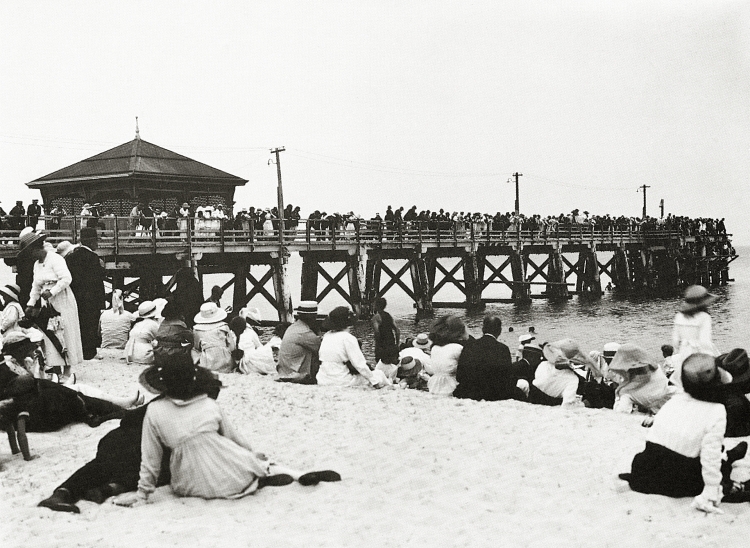
In the very early days at Cottesloe beach, picnics on the sand, listening to bands playing, promenading etc. were more popular than swimming – there were no facilities for changing into swimsuits – and modesty prevented many from even considering donning a bathing costume and entering the water where there were other people doing the same thing!
In March of that 1899 – getting ready for the next summer, bathing bylaws were gazetted. The provision of crude bathing boxes catered for the daring who were modest but also wanted to swim. DECENCY was the byword from the start.
The beach was the place to go for relaxation and amusement, not necessarily swimming. Early settlers brought with them English moral standards which meant that ‘skin was not to be revealed’ (Wells, 1982). There was no problem with bathing suits in the very early days and no doubt the bathing bylaws were carefully worded to ensure decency. Nevertheless during one incident, the Roads Board had to write to Mr Septimus Burt (of Burt’s summer residence, Cottesloe) regarding his son who had been bathing without trunks, contrary to the bylaws. The temptation which came with living so close to the sea on Swanbourne Terrace must have been too much for young Burt.
Two significant years in the early history of Cottesloe are 1905, when the Hotel Cottesloe was built, and 1906 when the jetty was constructed. By this time the popularity of the beach had increased considerably and so had the desire to be in the water swimming. To meet the needs of the swimmers, more substantial bathing boxes or ‘machines’ were placed on the beach to facilitate changing. Mr Page was a well-known provider at Cottesloe beach. Page was granted his permit to lease boxes with no charge because these devices had not been successful in South Australia. He was to pay 20 pounds in the second year and a hundred pounds in the third year. But meanwhile the Roads Board built bathing sheds and some boxes too so Page moved on to North Cottesloe where he helped to establish the popularity of that beach.

Once built, the jetty became a focal point of many activities on Cottesloe beach. The Roads Board framed bylaws to control the use of the jetty and the first of the 14 rules was that no bathing was allowed from the pier. An additional bylaw was suggested – that bathers over 6 years of age shall be clothed from neck to knee.
In 1910 the Council decided to allocate a space on the beach for ladies and children under 12 years, presuming that many lady swimmers objected to bathing amongst gentlemen. A concentration on the bathing costume soon developed.
In 1911 it was decided by Council that an apron be added to bathing garments-as if the material wasn’t heavy enough! By 1925 a conference of local authorities had been held but there was little appreciation of attempts to regulate dress and conduct on beaches. It was resolved that ‘the costume to be worn on beaches be a two-piece costume, Canadian style, reaching from the neck to the knees in such a manner as to secure the observance of decency’. And as for scarlet or red costumes – definitely NO!

During the 1930s the general public kept an eye on decency on the beach. The Council received many letters of complaint when it was believed that improper dress had been worn. At this time Mayor John Black’s comments showed that he was a very progressive, reasonable man:
“People can have little or nothing on and still be well behaved, and on the contrary they may be fully dressed and most objectionable. It is a time of changing fashion …”
By 1934 young men had widely adopted the practice of ‘rolling down’ the tops of their bathers. There were some prosecutions but little official action. In fact the Council was generally sympathetic. When surfies rolled down their suits and then came in on a wave they often lost their bathers accidentally and had to shriek to nearby females to keep them away until they had reclaimed their bathers from the water!
The appearance of rubber bathers, in conjunction with Cottesloe Week in 1934 drew attention once again to costumes and it was noted that the definition of ‘proper costume’ did not say that parts of the garment may not be cut out. The Minister for Local Government, Mr Spooner, proposed to frame a new ordinance – it stated that this was permitted as long as certain parts of the body were amply covered. Gradually, the new swimsuits began to be noticed and shopkeepers had to make up their minds about stocks!
In November of that year a new type of two-piece bathers appeared at North Cottesloe beach. This 2-piece suit for girls left uncovered an area of body between the two pieces. The costume was described in the Daily News in detail. The garment described was brown and white, backless, with strings tied around the neck and waist. The brief trunks fitted neatly to the figure, and newspapers predicted a short life for the two-piece bathers because the ‘civic fathers’ would think that the ‘brassiere and snugly fitting abbreviated trunks was carrying things too far’. In fact many of the councillors, and Mayor Black, were sympathetic to the changes but they had to deal with complaints from indignant ratepayers.

The surfers’ problems were solved in 1935. Although in January of that year the regulations required ‘legs [of the costume] be at least 3 inches, the bathers to cover the body in part up to the armpits and back up to the waist, and with a half skirt covering the front from the waist down’, in February the Council of the Surf Life Saving Association of NSW gave approval for the wearing of trunks on beaches. By September there was strong criticism of the local bylaw at Cottesloe. Then in November the newspapers carried the exciting headline – ‘Bare Torsos – Nedlands approval of male bathers’. The article advised that the Nedlands Roads Board had approved a beach bylaw permitting men to wear bathing costumes without tops, i.e. TRUNKS! This was in line with proposals adopted by a conference of metropolitan Local Authorities. The bylaw recommended was: In the case of males the trunks of bathers shall be supported by a belt at the waist if same is not otherwise supported with shoulder straps’. Women soon benefited by the deletion of the requirement that the length of legs was to be 3 inches.

Even so, Cottesloe was hesitant to adopt the new bylaw, and by 1937 there was reference to bathing trunks getting scantier and scantier. In July of that year the Cottesloe Council received a letter regarding men’s bathers offered in a shop ‘consisting of single piece trunks without reinforcement and without a zip front’. But that month also saw the appearance of stretchable bathers made from a rubber composition – a suit only 12 inches long could stretch to fit! The new swimsuit was known as the ‘telescope’.
Perhaps 1945-46 was the last significant summer in the history of the swimsuit. This was when the bikini made its appearance. It was the work of a frenchman, Louis Reard, whose swimsuit was tiny but significant. It was reported to be the smallest bathing suit in the world, not genuine unless it could be pulled through a wedding ring! Reard was born in 1896. and began his career in 1925 with knitted bathing suits. By 1960, the bikini had become so popular that others produced the same kind of garment but were not allowed to call them ‘bikinis’. Reard died in 1984.
Swanbourne nudist beach was established in 1961 – many years ago now. And the very young today are enjoying the beach in what can only be described as neck-to-knee attire – but in the most brilliant of colours and for very different reasons.
Adapted for publishing from The Cottesloe Society Newsletter with the permission of Ruth Marchant James.
